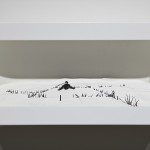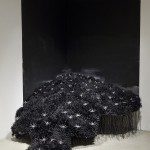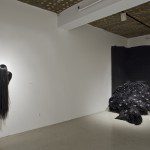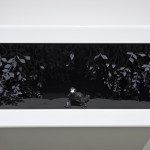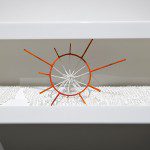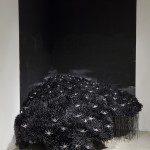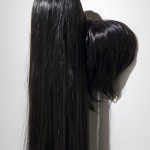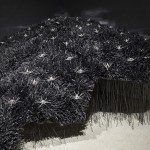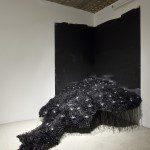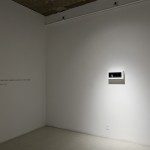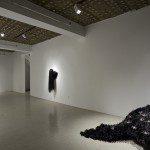We live in a culture that is losing its collective sense of wonder. With daily tragedies and horrors on the 6 o’clock news, it is easy to become numb. Sherri Hay has the rare ability to shock with her art. The theatrical subjects that she depicts in her works are becoming increasingly ethereal and other-worldly.
Hay is known for her disaster globes, 5-inch snow globes, transparent spheres filled with both attached and free-floating white polystyrene cut into buildings and highways. When shaken, the tiny people trapped inside fall to their dismal fates, cars spin through the air and silently crash, enacting calamities that we bear witness to and hear about secondhand. We are left to construct their micro-narratives. In this exhibition, entitled The place where you live is lit by the sun, Hay’s work moves further from the familiar. A 2-foot Plexiglas square box holding water is reminiscent of the disaster globes in its materials and movement, but is slightly more abstract and much more hopeful. Beads of condensation drip down the inside of the container in tiny rivulets, and suggest potential regeneration in the form of a small, safe ecosystem.
Nature in these works is exotic and outlandish. Genderless, almost-human forms covered in flowers offer a reverse anthropomorphism, where bodies bloom with delicate leaves and lilies, each petal giving a small performance. While Hay has constructed other flower people and hand-painted them in bright colours, it is notable that the latest piece, The first star hangs between his feet, is monochromatic. There is great attention to light in this work, calling attention to the contrasts, shapes and surfaces of the disembodied landscape. In it, a leaf-covered creature emerges on the horizon, crawling beneath a canopy of delicate vines on all fours, leaves fanned into hands. Its face is slightly in profile, but there are no features to search for emotion. A lone white bloom punctuates its head like a bold accessory, an adornment against the skin of leaves. The ambiguities in the work create interest as one cannot be sure whether this character is the hunter or the hunted.
Hay’s work is an incongruous combination of movie set, outer space and ecological disaster. She takes pleasure in blurring the boundaries between science fiction and social reality, providing a land populated by chimeras and cyborgs that stimulate the imagination.


